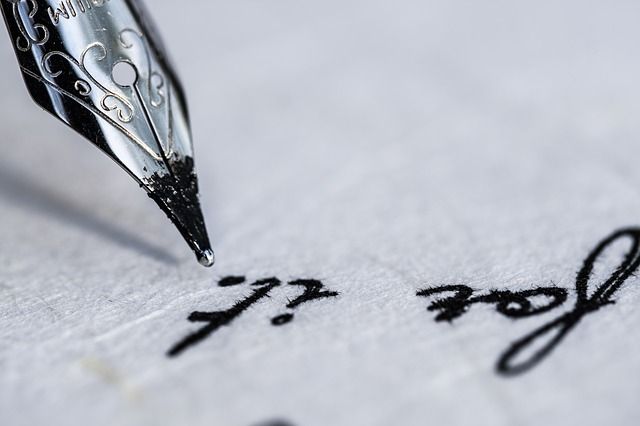How to Write a Formal Letter in French
When you're studying French, there may be instances where you need to write a formal letter in French. For example, if you're applying for an exchange program in a campus in France. If you have zero clue in writing a letter in French, no worries. I've got you covered.

When you're studying French, there may be instances where you need to write a formal letter in French. For example, if you're applying for an exchange program in a campus in France. If you have zero clues in writing a French letter, no worries. I've got you covered.
It may sound unbelievable, but in the world of texts, Snapchats, and Instagram stories, French people still hold writing skill very dearly.
It is no wonder then, for French people, eloquent formal letters are taken in high regard. A well-written formal letter often gets more attention than one that doesn't look as polished.
Also, some formal letters are considered legally binding in France, for example, letters that are used to inform your boss of your resignation.
The funny thing is: formal French letters tend to be more formal than formal English letters. For starter, in French, there's a strict structure to follow. It's advised to avoid all abbreviations as well.
To be completely honest, even the native French dread to write a formal letter in French.
However, there's no need to weep in a fetal position if you need to write one.
Follow the step-by-step in this article to write a great formal letter in French. I'll also include ready-to-use French letter phrases that you can copy and paste directly into your letter.
And because we're super nice people, you can download a French formal letter example at the end of this article!

Before You Start to Write a Fench Letter
Before anything else, you need to know a few things to "prime" your letter. Understanding these will help you be in the right state of mind right from the start.
1. Know Your Reader
The politest thing to do is address your letter directly to the person: 'Monsieur Dupont' or 'Madame Bijoux'.
- This will show you've done your research – thus impress the person reading it, and
- It helps you visualize the person you're writing to. This seems like a useless thing, but writing by keeping a particular person in your head helps a great deal in choosing the words.
What if, after a ton of research, you still don't know? In that case, try as best as you can to know the gender of the person to be able to say 'Monsieur' or 'Madame'.
If you still can't find that, use 'Madame/Monsieur'. Some people will tell you to use only 'Monsieur' or 'Messieurs' (Sir or Sirs), and some will even tell you that French still do this sexist practice. Not in 2018, mes amis!
To summarize, here’s a quick reference guide for an opening a formal letter opening:
If you know the name of the person- Monsieur X / Madame X
If you do not know the gender OR name of the person- Madame, Monsieur
If you know the gender but do not know the name or title- Madame / Monsieur
If you want to address it very generally (a bit old-fashioned)- Messieurs
If you know the gender and title- Monsieur le Directeur / Madame la Directrice
2. Be 100% Formal
French letter writing is a form of art which asks you to be rigorous and creative at the same time. In practice, this means:
- It's always 'vous' and never 'tu' in a formal letter.
- Never use a slang word or phrase, EVER.
- Dot all the i's and cross all the t's. In French, this translates into not forgetting any accent, capital letter or apostrophe.
- Try to avoid grammar mistakes as much as you can. However, if the reader knows you're a learner, errors are very forgivable.
3. One Page Maximum
Write it well, write it efficiently. Unless you can't do otherwise, fit your words on one page.
This is even more important when it's a resume (Curriculum Vitae in French) or an application letter. It's then crucial to delete any fluff and edit your sentences like a hawk.

The Structure of a Formal French Letter
Believe it or not, there's a structure to follow in how to write a formal letter in French that very few people dare to deviate from. It's like the unspoken golden rule.
When I was studying to get my degree in French letters, this was a module. That's how important this structure is.
- Your name and address
- The name and the address of the person you're writing to
- Place and date
- The purpose of your letter
- Opening paragraph – 1 paragraph
- The "meat" of your letter (why you're writing) - 2 to 3 paragraphs
- Closing paragraph – 1 paragraphs
- Your signature
To see how this structure pans out in real life, check out the example below!

Let's Write a Formal Letter in French!
Let's do a walk-the-talk part, shall we?
Here at Speechling, we take pride in helping you practice as we believe that doing is the best way of learning.
We're going to use sentences and words that one often uses when writing a formal letter so you can re-use them. You can also download the final product at the end of this article.
You WILL need to change some if not many of the elements here, so use your best judgment.
For the sake of continuity with my example in the very beginning, let's do a school application letter. For example, one you'll need to write if you want to be an exchange student at a university in France.
In French, this is called 'une lettre de motivation'.
This means that you're supposed to:
- detail your motivation to apply – emphasizing on why you're interested in their program.
- give the reasons why you think you deserve to be accepted.

1. The Letter Head
To make things simpler, let's follow the structure of the letter provided above.
-
The easy part: put your name and address in the top left corner of your letter.
-
After you've found out the exact person you're adressing to, put his/her name and address in the top right corner of your letter.
For the purpose of example, let's say that we don't know who's responsible for the student exchange program. So, you can write something like this:
Directeur du Programme d'échanges
Université Panthéon-Sorbonne 1
17 rue de la Sorbonne
75005 Paris
If you feel that addressing it to the Head of Department is better, use this:
Directeur de la Faculté de Langues
(or whatever faculty it is you wish to enter).
- After, put a place and date of writing. You can put this under the name and address of the person you're writing to.
Sydney, le 3 mai 2018
- Don't forget to put the purpose of your letter.
Objet: Candidature pour un semestre académique à la Faculté de langues
Translation: Subject: Application to a semester of exchange at the Languages Faculty
2. Opening Your Letter
Now, the top of your letter is done. PHEEW!!
Let's write the "real" thing.
- As we said earlier, we don't know the gender of the person reading your letter. So, open your letter like this:
Madame, Monsieur,
However, if you know the name of the person, use his/her family name only:
Monsieur Dupont,
Avoid using 'Cher Monsieur' or 'Chère Madame' to open your letter (Dear Sir or Dear Madam). Remember that this is a 100% formal letter.
Keep the 'Dear Sir/Madam' if you know him/her personally only.
- Then, write your one opening paragraph. Keep this short!
The smartest way to do this it to avoid the fluff 'My name is Serina, and I'm writing to you because...'
Instead, write something like this:
Étudiant(e) en 3ème année en Lettres Françaises à l'Université de Sydney, je souhaite vivement intégrer votre formation afin de réaliser un semestre académique via le programme d'échanges.
(As a 3rd-year student in French Letters at the University of Sydney, I would very much like to follow an academic semester in your faculty via the exchange program.)
Yes, that's one sentence that's also a paragraph. It already packs a bit of who you are and why you're writing this particular letter.

3. The Content of Your Letter
Let's continue our letter with the 'meat of our sandwich', aka the most important part of your letter.
This is an example:
Pour me préparer au mieux au monde de travail après mon cursus universitaire, séjourner en France représente un réel tremplin. Grâce au programme d'échanges proposé à l’Université Panthéon-Sorbonne 1, je pourrai à la fois parfaire mes connaissances en Français et découvrir une culture à laquelle je m’intéresse depuis plusieurs années.
(To prepare myself better for the professional world after my studies, living in France would be a real springboard. Thanks to the exchange program offered by the University Panthéon-Sorbonne 1, I will be able to both practice French and discover the culture which I have been interested in for years.)
Aussi curieux(euse) que motivé(e), je saurai tirer profit personnellement mais aussi professionnellement de ce programme en France. Je vois également ce séjour dans une université française comme une étape incontournable de mes études supérieures et un atout majeur dans la construction de mon projet professionnel.
(As a curious and motivated person, I'll be able to take advantage personally and professionally of this program in France. I also see this exchange in a French university as an essential step in my studies and a major asset as I'm building toward my professional project.)
In these two short paragraphs, you have managed to:
- Give pertinent details of who you are and why you're a great fit (you're interested in the culture, motivated and curious).
- Elaborate on the reasons you're applying (you're planning to use this opportunity to build personal character and jumpstart a career in the future).
4. French Letter Closing
Ideally, write your closing in one paragraph only.
But if there's a minor additional detail you wish to say and or don't like the cramped look, it's better to have a two 'faux-paragraphs' in this section.
For example:
J'attache mon Curriculum Vitae à cette lettre pour que vous puissiez en prendre compte.
is better written as a small paragraph of its own.
Translation: I attach my resume to this letter so that you can take it into account.
Otherwise, you can use this as your closing paragraph:
Je me tiens à votre entière disposition pour tous renseignements complémentaires et vous prie, Madame, Monsieur, d'agréer l'expression de mes respectueuses salutations.
(I'm at your disposition if you need any additional information and I wish that you would, Madame, Monsieur, accept my respectful salutations.)
Another common French letter closing:
En vous remerciant de l'attention que vous portez à cette lettre, je vous prie d’agréer, Madame, Monsieur, l'expression de mes sentiments distingués.
(I thank you for the attention you gave to this letter, and please accept, Madame, Monsieur, the assurances of my highest considerations.)
In the right bottom corner of your letter, write your name preceded by:
Respectueusement,
(Respectfully,)
To summarize, here are some great options for closing a formal letter:
Je vous prie d’agréer, X, l’expression de mes salutations distinguées/ mes sentiments distingués- The literal translation doesn't sum up the meaning, but it's a way to close a very formal letter in French. Careful to spell “distingué” correctly! “Salutations” is feminine but sentiments is masculine, thus the difference!
Je vous prie d’agréer, X, l’expression de mes salutations dévouées- similar to the above, but usually used in a letter from someone who is providing a service.
Je vous prie d’agréer, X, l’expression de mes sentiments distingués.- very formal, but a bit more personal
Respectueusement, Cordialement- much less formal, but still polite
If you have a digital signature handy, you can use that too, to sign your letter.
And... you're done! High five!

5. Download and Use This Letter
To download this example of a formal French letter, click here. Do not forget, however, to edit it as your need/situation.
For example:
If you're a girl, use 'étudiante,' 'motivée' and 'curieuse.'
Change also the program/university/faculty name as your real need.
Also, important note: If you know the name of the person, change all 'Madame, Monsieur' into the person you're writing to.
En vous remerciant de l'attention que vous portez à cette lettre, je vous prie d’agréer, Madame Bijoux, l'expression de mes sentiments distingués.
Well, how can I write a letter in French to my friend?
Don’t worry—I got you covered with some suggestions on how to write a letter in French to a friend or family member, too!
Since you wouldn’t have to worry so much about a heading, you really only need to know how to open the letter (Dear….) and close it out (From…). The rest is up to you!
Suggestions on how to start your letter in French:
Opening:
Cher X (for a boy), chère X (for a girl) - translates as "dear" (if you’re going for plural, it’s chers/chères)
Salut, X! - Hi!
Coucou! - Hiya! Literally means knock, knock
Bonjour, X! - Hello, X!
Closing:
Bises, bisous-kisses (this isn’t just romantic! Friends and family say it, too!)
Je t'embrasse – I hug you, or “hugs”!
Je vous embrasse – I hug you all (meant for more than one person)
But what about how to write an email in French?
In the electronic age, you may very well not only write a formal letter; you may also write a formal email.
Colleges, businesses, jobs--they all often communicate by email. That means that you need to be able to project a positive image of yourself across a keyboard. And that's also why it's just as important to know how to write an email in French.
The good news? For the most part, most of the rules stay the same. A formal letter in French can be found on paper or in an inbox. The French simply prefer more formal means of communication.
However, just like an email in English, you’ll have a “subject” or, in French, “objet” which tells the recipient what the email is about. Choose a keyword that is professional, such as “appartement” or “poste de professeur.”
An email in French will probably be a bit shorter. For the rest of it, like the salutation and closing, you can stick to the reference guide above in very formal situations, such as applying for a job, writing a customer or asking a business for a service.
In fact, let’s also add to the list the very formal:
"Dans l’attente de votre réponse, nous vous prions d’agréer, Madame, Monsieur, nos salutations les meilleures."
Since emails are by nature more brief than a letter, you can also opt for
"Cordialement" and "Mes Salutations." This is especially more appropriate when responding to an ad for a product someone is selling, for example.
You can find a sample email from someone wanting to rent an apartment. Just don’t forget to edit it as needed!
And voilà...that's it!
Final Words
There are many reasons to write a formal letter, and we've just covered one of them. However, the phrases we used above are very versatile, and you can recycle them to fit your purpose.
The most important thing to remember is this: do NOT panic.
Your letter doesn't have to be perfect. You can have it looked at by your French teacher, for example. But really, even if it's not 100% polished and in perfect grammar, everything's is going to be okay.
As I always say, "French people really appreciate the fact that you're learning their difficult language." Here's a standing ovation for your efforts!